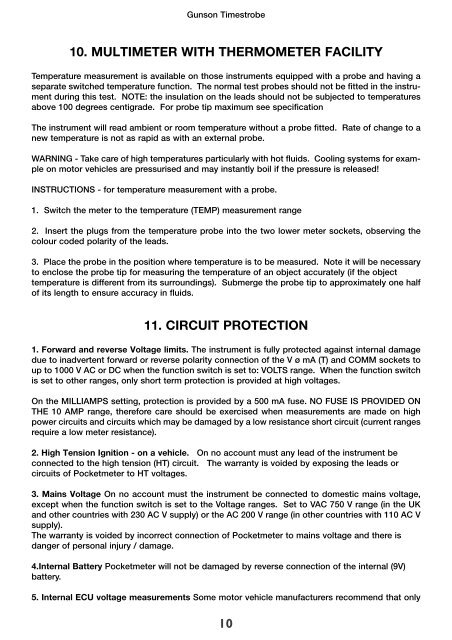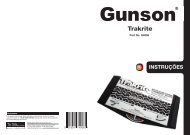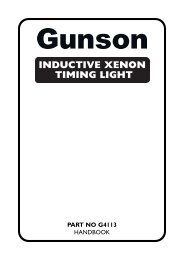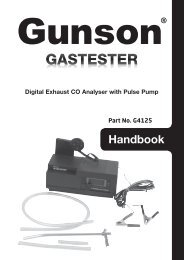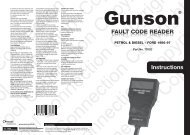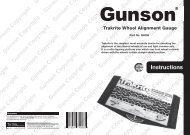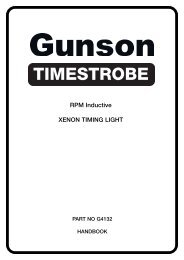POCKETMETER 2 - Gunson
POCKETMETER 2 - Gunson
POCKETMETER 2 - Gunson
Create successful ePaper yourself
Turn your PDF publications into a flip-book with our unique Google optimized e-Paper software.
<strong>Gunson</strong> Timestrobe<br />
10. MULTIMETER WITH THERMOMETER FACILITY<br />
Temperature measurement is available on those instruments equipped with a probe and having a<br />
separate switched temperature function. The normal test probes should not be fitted in the instrument<br />
during this test. NOTE: the insulation on the leads should not be subjected to temperatures<br />
above 100 degrees centigrade. For probe tip maximum see specification<br />
The instrument will read ambient or room temperature without a probe fitted. Rate of change to a<br />
new temperature is not as rapid as with an external probe.<br />
WARNING - Take care of high temperatures particularly with hot fluids. Cooling systems for example<br />
on motor vehicles are pressurised and may instantly boil if the pressure is released!<br />
INSTRUCTIONS - for temperature measurement with a probe.<br />
1. Switch the meter to the temperature (TEMP) measurement range<br />
2. Insert the plugs from the temperature probe into the two lower meter sockets, observing the<br />
colour coded polarity of the leads.<br />
3. Place the probe in the position where temperature is to be measured. Note it will be necessary<br />
to enclose the probe tip for measuring the temperature of an object accurately (if the object<br />
temperature is different from its surroundings). Submerge the probe tip to approximately one half<br />
of its length to ensure accuracy in fluids.<br />
11. CIRCUIT PROTECTION<br />
1. Forward and reverse Voltage limits. The instrument is fully protected against internal damage<br />
due to inadvertent forward or reverse polarity connection of the V ø mA (T) and COMM sockets to<br />
up to 1000 V AC or DC when the function switch is set to: VOLTS range. When the function switch<br />
is set to other ranges, only short term protection is provided at high voltages.<br />
On the MILLIAMPS setting, protection is provided by a 500 mA fuse. NO FUSE IS PROVIDED ON<br />
THE 10 AMP range, therefore care should be exercised when measurements are made on high<br />
power circuits and circuits which may be damaged by a low resistance short circuit (current ranges<br />
require a low meter resistance).<br />
2. High Tension Ignition - on a vehicle. On no account must any lead of the instrument be<br />
connected to the high tension (HT) circuit. The warranty is voided by exposing the leads or<br />
circuits of Pocketmeter to HT voltages.<br />
3. Mains Voltage On no account must the instrument be connected to domestic mains voltage,<br />
except when the function switch is set to the Voltage ranges. Set to VAC 750 V range (in the UK<br />
and other countries with 230 AC V supply) or the AC 200 V range (in other countries with 110 AC V<br />
supply).<br />
The warranty is voided by incorrect connection of Pocketmeter to mains voltage and there is<br />
danger of personal injury / damage.<br />
4.Internal Battery Pocketmeter will not be damaged by reverse connection of the internal (9V)<br />
battery.<br />
5. Internal ECU voltage measurements Some motor vehicle manufacturers recommend that only<br />
10


